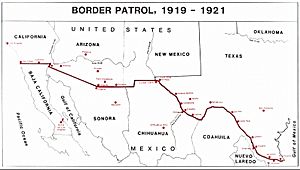Camp Harry J. Jones facts for kids
Camp Harry J. Jones was an important military camp for the United States Army. It was located near Douglas, Arizona, and was active during the time of the Pancho Villa Expedition and World War I.
Contents
History of Camp Jones
The U.S. Army set up a camp near Douglas, Arizona, in 1910. This was one of many camps built along the border with Mexico. Their job was to keep the border safe during the Mexican Revolution.
In 1916, the camp was renamed Camp Jones. This was done to honor a soldier who was accidentally shot. He was on guard duty during a battle between Mexican forces. This battle, called the Second Battle of Agua Prieta, happened right across the border from Douglas.
Camp Jones was very important during the 1916-1917 Pancho Villa Expedition. This mission was led by General John J. Pershing. Several cavalry units, which are soldiers who ride horses, were based there. They helped keep the area safe from attacks by Pancho Villa's forces. The camp also served as a meeting point for the Arizona Army National Guard. They gathered there before joining the expedition.
During the Pancho Villa Expedition, soldiers at Camp Jones started using new technology. They used cars and trucks a lot. They also used airplanes for looking around and scouting. This was one of the Army's first big steps in using motorized vehicles. It showed that the Army would soon move away from using horses and mules.
Camp Jones During World War I
Camp Jones stayed an important place during World War I. It was the main office for the Army's Arizona District. Soldiers stationed there kept patrolling the U.S. border with Mexico. They wanted to stop any possible attacks by German soldiers or spies.
Closing Down Camp Jones
Camp Jones closed in January 1933. This happened during the Great Depression, a time when money was very tight. The government wanted to save money by closing some border posts. Leaders in Douglas and Arizona tried to stop the closure, but they couldn't.
Many soldiers from Camp Jones were moved to Fort Huachuca, another nearby army base. Soldiers from the 10th Cavalry Regiment helped move buildings and equipment. Much of it was sold or taken to Fort Huachuca. Today, there are no signs left of Camp Jones. The area where the camp once stood is now a neighborhood in Douglas.
Where Camp Jones Was Located
The main entrance to Camp Jones was at the east end of 10th Street in Douglas. Maps from that time show the camp was bordered by North Washington Avenue on the west. East 13th Street was to the north, and 1st Street was to the south. This area is roughly between Calvary Cemetery and the Douglas Municipal Airport.
People Connected to Camp Jones
Many notable people served at Camp Jones, including:
- DeRosey Caroll Cabell: He was the commander of the Arizona District during World War I.
- James M. Gavin: He was part of the 25th Infantry Regiment at Camp Jones from 1929 to 1932.
- William H. Hay: He commanded the 1st Cavalry Brigade at Camp Jones from 1922 to 1924.
- Edward McGlachlin Jr.: He also commanded the Arizona District during World War I.
- Troy H. Middleton: He served with the 7th Infantry Regiment during the Second Battle of Agua Prieta.
- George H. Morgan: A Medal of Honor winner, he commanded Camp Jones during World War I.
- Lucian Truscott: He was stationed at Camp Jones with the 17th Cavalry Regiment during World War I.
- Leroy H. Watson: He served at Camp Jones with the 22nd Infantry during the Pancho Villa Expedition.


